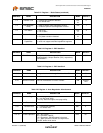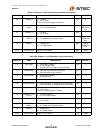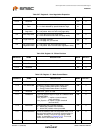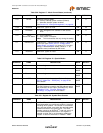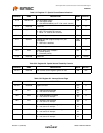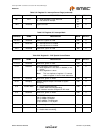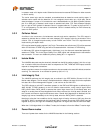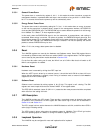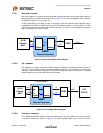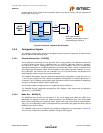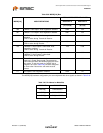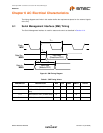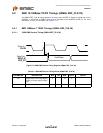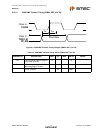
Small Footprint RMII 10/100 Ethernet Transceiver with HP Auto-MDIX Support
Datasheet
Revision 1.0 (05-28-09) 50 SMSC LAN8720/LAN8720i
DATASHEET
in repeater mode or full-duplex mode. Otherwise the transceiver asserts CRS based on either transmit
or receive activity.
The carrier sense logic uses the encoded, unscrambled data to determine carrier activity status. It
activates carrier sense with the detection of 2 non-contiguous zeros within any 10 bit span. Carrier
sense terminates if a span of 10 consecutive ones is detected before a /J/K/ Start-of Stream Delimiter
pair. If an SSD pair is detected, carrier sense is asserted until either /T/R/ End–of-Stream Delimiter
pair or a pair of IDLE symbols is detected. Carrier is negated after the /T/ symbol or the first IDLE. If
/T/ is not followed by /R/, then carrier is maintained. Carrier is treated similarly for IDLE followed by
some non-IDLE symbol.
5.3.2 Collision Detect
A collision is the occurrence of simultaneous transmit and receive operations. The COL output is
asserted to indicate that a collision has been detected. COL remains active for the duration of the
collision. COL is changed asynchronously to both RXCLK and TXCLK. The COL output becomes
inactive during full duplex mode.
COL may be tested by setting register 0, bit 7 high. This enables the collision test. COL will be asserted
within 512 bit times of TXEN rising and will be de-asserted within 4 bit times of TXEN falling.
In 10M mode, COL pulses for approximately 10 bit times (1us), 2us after each transmitted packet (de-
assertion of TXEN). This is the Signal Quality Error (SQE) signal and indicates that the transmission
was successful. The user can disable this pulse by setting bit 11 in register 27.
5.3.3 Isolate Mode
The LAN8720 data paths may be electrically isolated from the MII by setting register 0, bit 10 to a logic
one. In isolation mode, the transceiver does not respond to the TXD, TXEN and TXER inputs, but does
respond to management transactions.
Isolation provides a means for multiple transceivers to be connected to the same MII without contention
occurring. The transceiver is not isolated on power-up (bit 0:10 = 0).
5.3.4 Link Integrity Test
The LAN8720 performs the link integrity test as outlined in the IEEE 802.3u (Clause 24-15) Link
Monitor state diagram. The link status is multiplexed with the 10Mbps link status to form the reportable
link status bit in Serial Management Register 1, and is driven to the LINK LED.
The DSP indicates a valid MLT-3 waveform present on the RXP and RXN signals as defined by the
ANSI X3.263 TP-PMD standard, to the Link Monitor state-machine, using internal signal called
DATA_VALID. When DATA_VALID is asserted the control logic moves into a Link-Ready state, and
waits for an enable from the Auto Negotiation block. When received, the Link-Up state is entered, and
the Transmit and Receive logic blocks become active. Should Auto Negotiation be disabled, the link
integrity logic moves immediately to the Link-Up state, when the DATA_VALID is asserted.
Note that to allow the line to stabilize, the link integrity logic will wait a minimum of 330 μsec from the
time DATA_VALID is asserted until the Link-Ready state is entered. Should the DATA_VALID input be
negated at any time, this logic will immediately negate the Link signal and enter the Link-Down state.
When the 10/100 digital block is in 10Base-T mode, the link status is from the 10Base-T receiver logic.
5.3.5 Power-Down modes
There are 2 power-down modes for the LAN8720 described in the following sections.



